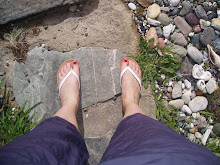Condition 3: Jaundice
Final due: 16th October, Peer assessment due: 23rd October 2009.
Description:
Jaundice (Icterus) is the yellowing of the skin as a result of uncommonly high amounts of bilirubin in the blood plasma. Bilirubin affects skin pigment, is a byproduct of broken down haemoglobin and is metabolised in the liver. Therefore, blood disorders, diseases of the liver and gall bladder problems can affect the metabolism of these organs/tissues resulting in an unusually high level of bilirubin (Premkumar, 1999).
Jaundice is the physical symptom of a more serious underlying condition. Hepatic jaundice which is the most common type, is often co-morbid with other serious internal diseases affecting the liver, most often hepatitis (Brienza et al, 2006).
Etiology:
Hepatic jaundice is typically caused by liver disease/failure, which can be caused by prescription drugs including antibiotics (Hussaini et al, 2007), alcohol leading to cirrhosis of the liver and other toxic substances, hepatitis, viral diseases such as malaria (Werner, 2005) and other chronic liver conditions (Suman & Carey, 2006). In very rare cases, there may be abnormal liver enzyme activity present from birth, this is known as congenital jaundice (Werner, 2005).
Signs & Symptoms:
The most obvious signs that jaundice is present are that the whites of the eyes, skin and mucous membranes will appear yellow (due to the pigment change caused by elevated levels of bilirubin). There may be a dull aching pain in the upper right quadrant of the abdomen and enlargement of the spleen in addition to jaundice in the case of co-morbid hepatitis (Premkumar, 1999)
Light coloured stools and dark urine also indicate abnormal levels of bilirubin in the blood and the presence of jaundice (Werner, 2005).
Morphology:
Jaundice may eventually result in bleeding disorders if the underlying condition responsible is left untreated, as the higher levels of bilirubin indicate that bile is not being adequately secreted, preventing the absorption of fats and therefore inhibiting the access of fat soluble vitamins (such as Vitamin K) that assist in normal blood clotting (Werner, 2005).
Incidence & Prevalence:
Incidence and Prevalence of jaundice will depend entirely on the underlying hepatic condition, as jaundice is only a physically manifested symptom.
In a study undertaken in France, medical researchers found that the incidence of drug-related hepatic injury was 14 in 100,000 citizens each year (Navarro & Senior, 2006). According to Wasley et al (2007) 20 - 30% of recently infected American hepatitis patients additionally presented with jaundice in 2005.
Indications for MT:
The therapist must first identify the underlying condition resulting in the presence of jaundice, and take the necessary precautions according to this condition (Werner, 2005). Generally, reduced session length, relaxation style massage with light pressure only and avoidance of the liver and spleen areas (upper abdomen) are advised. If the patient presents with any form of hepatitis (including viral hepatitis) in addition to jaundice, the therapist must take stringent hygiene precautions, ask the client to leave their underwear on during the massage and preferably be vaccinated against all Hepatitis strains, particularly Hepatitis B (Premkumar, 1999).
Contraindications for MT:
Avoid moderate to heavy massage of the abdomen due to possible enlargement of the liver and spleen or do not massage this area at all (depending on their underlying condition/s). Do not use heavier than relaxation pressure as this can easily lead to bruising, if the client presents with underlying bleeding disorders (Werner, 2005).
Massage is generally contraindicated when jaundice is apparent (and the cause unknown), as this is a warning sign of a more serious hepatic illness and massage could inflame the liver further.
References:
Brienza, N., Dalfino, L., Cinnella, G., Diele, C., Bruno, F. & Fiore, T. (2006) Jaundice in Critical Illness: Promoting Factors of a Concealed Reality. Intensive Care Medicine, 32 (2).
Hussaini, S., O'Brien, C., Despott, E. & Dalton, H. (2007) Antibiotic Therapy: A Major Cause of Drug Induced Jaundice in Southwest England. European Journal of Gastroenterology & Hepatology, 19 (1).
Navarro, V. & Senior, J. (2006) Drug-Related Hepatotoxicity. The New England Journal of Medicine, 354 (7).
Premkumar, K. (1999) Pathology A-Z: A Handbook for Massage Therapists. Calgary: Lippincott Williams & Wilkins, pp. 209 - 211
Suman, A. & Carey, W. (2006) Assessing the Risk of Surgery in Patients With Liver Disease. Cleveland Clinic Journal of Medicine, 73 (4).
Werner, R. (2005) A Massage Therapist's Guide to Pathology. Philadelphia: Lippincott Williams & Wilkins.
Wasley, A., Miller, J. & Finelli, L. (2007) Surveillance for Acute Viral Hepatitis - United States 2005. MMWR: Surveillance Summaries, 56 (SS03).

No comments:
Post a Comment